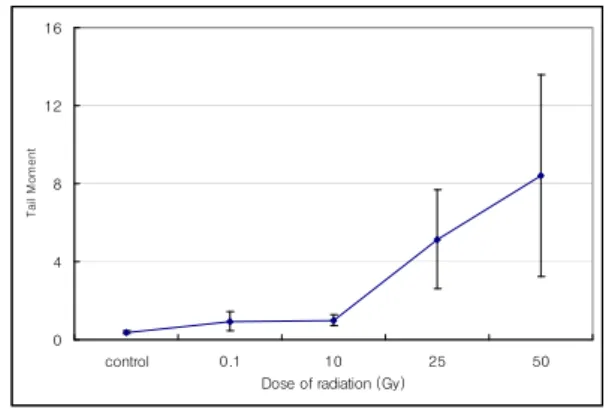2010년도 춘계 학술발표회 논문집 대한방사선방어학회
140_http://www.karp.or.kr
DNA Damage by Radiation in Tradescantia Leaf Cells
Min Han1), Kyung Man Hyun1), Tae Ho Ryu1), Mohammad Nili2), Jin Kyu Kim1)
1Korea Atomic Energy Research Institute, Advanced Radiation Technology Institute, Jeongeup 580-185, Korea
2Dawnesh Radiation Research Institute, Barcelona 08007, Spain E-mail: jkkim@kaeri.re.kr
Key words : Tradescantia, comet assay, ionizing radiation, DNA damage
Introduction
The comet assay is currently used in different areas of biological sciences to detect DNA damage. The comet assay, due to its simplicity, sensitivity and need of a few cells, is ideal as a short-term genotoxicity test [1,2]. The comet assay can theoretically be applied to every type of eukaryotic cell, including plant cells. Plants are very useful as monitors of genetic effects caused by pollution in the atmosphere, water and soil [3].
Tradescantia tests are very useful tools for screening the mutagenic potential in the environment [4]. Experiments were conducted to study the genotoxic effects of ionizing radiations on the genome integrity, particularly of Tradescantia [5]. The increasingly frequent use of Tradescantia as a sensitive environmental bioindicator of genotoxic effects [6]. This study was designed to assess the genotoxicity of ionizing radiation using Tradescnatia-comet assay.
Materials and Methods
Leaf sampling and irradiation
Without any visible injury, 6 leaves of Tradescantia KU 9 were randomly collected from inner positions. Average leaf sizes of Tradescantia were ranged between 5 ~ 6 cm in length. Leaf samples packed in a conical tube were irradiated
at 0.1, 10, 25, 50 Gy using a 60Co irradiator at the Korea Atomic Energy Research Institute
Comet assay and analysis
After irradiation Tradescantia leaf samples are gently sliced with a fresh razor blade. The dish is kept tilted in the ice so that the nuclei would collect in the buffer. 70㎕ of nucleoid suspension was mixed in 700㎕ of warm low melting point agarose solution. The mixture was then layered on coated slide. The prepared slide was put into a lysis solution at 4 ℃ for 1 hr, and then slides were placed in the alkaline buffer for 20 min to allow unwinding of the DNA. The electrophoresis apparatus was operated at 25V/cm with constant 300 mA for 10 min in an ice bath. After drying well, each slide was stained with 20 ㎍/㎖
ethidium bromide and covered with a cover glass before viewing under the fluorescent microscope.
The extent of DNA migration was determined using an image analysis system (Komet 4.0 from Kinetic Imaging Ltd., Liverpool). The DNA damage was evaluated by measuring tail length between comet head and tail and generally 50 cells were scored per dose.
Results and Discussion
Leaf samples were exposed to 0.1 ~ 50 Gy and samples for comet assay were prepared
2010년도 춘계 학술발표회 논문집 대한방사선방어학회
대한방사선방어학회_141 immediately. A significant dose-dependent
increase in the average median tail moment values over the negative control was observed (Fig. 1). As a rough estimate of DNA migration, the length of the comet tail was recorded versus its head diameter under different conditions. In the non-irradiated sample the tails can be seen, but the DNA comets are short. The comets from irradiated samples have longer tails that lengthen further as irradiation doses increase. The comet assay has demonstrated its sensitivity as a technique for the evaluation DNA damage among a variety of cell types, induced by a variety of physical and chemical agents [7]. The potential applications of the comet assay in such areas as genotoxicity, clinical, DNA repair, environmental biomonitoring and human monitoring are almost unlimited.
0 4 8 12 16
control 0.1 10 25 50
Dose of radiation (Gy)
Tail Moment
Fig. 1. The effects of dose of radiation on the average tail moment values of nuclei isolated from leaves of Tradescantia. Tail Moment = Tail length x Tail % DNA/100.
Conclusion
The development of comet assay has enabled investigators to detect DNA damage at the levels of cells. To adapt this assay to plant cells, nuclei were directly obtained from Tradescantia leaf samples. A significant dose-dependent increase in the average tail moment values over the negative
control was observed. Recently the adaptation of this technique to plant cells opens new possibilities for studies in variety area. The future applications of the comet assay could impact some other important areas, certainly, one of the limiting factors to its utility is the imagination of the investigator.
Reference
1. N. P. Singh, T. McCoy, R. R. Tice and E. L. Schneider, A simple technique forquantitation of low levels of DNA damage in individual cells, Exp. Cell Res., 175, 84-192(1988)
2. D. W. Fairbairn, P. L. Olive and K. L. O’Neill, The comet assay: a comprehensive review, Mutation Res. 339, 37-59(1995)
3. L.H. Weinstein, J. A. Laurence, R. H. Mandl and K. Wälti, Use of native and cultivated plants as bioindicators and biomonitors of pollution damage, in: W. Wang, J. W.
Gorsuch and W. R. Lower (Eds.), Plants for Toxicity Assessment, American Society for Testing Materials, Philadelphia, 117-126(1990)
4. T. H. Ma, G. L. Cabrera, R. Chen, B. S. Gill, S. S.
Sandhu, A. L. Vandenberg and M. F. Salamone, Tradescantia micronucleus bioassay, Mutation Research, 310, 221-230(1994)
5. G. S. Rodrigues, T. H. Ma, D. Pimentel and L. H.
Weinstein, Tradescantia bioassays as monitoring systems for environmental mutagenesis: a review, Critical Reviews in Plant Sciences, 16, 325-359(1997)
6. G. S. Rodrigues, S. A. Madkour and L. H. Weinstein, Genotoxic activity of ozone in Tradescantia, Environmental and Experimental Botany, 36, 45-50(1996)
7. E. Rojas, M. C. Lopez and M. Valverde, Single cell gel electrophoresis assay: methodology and applications, J. of Chromatography B, 722, 225-254(1999)
